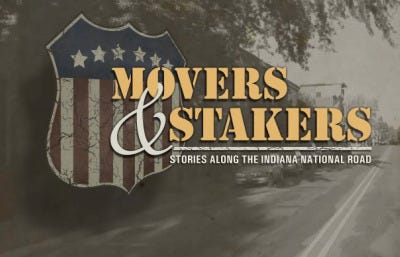Director Nancy Carlson, "Movers and Stakers"

Get Indy Film showtimes for this film by clicking here.
Movers and Stakers: Stories along the Indiana National Road was one of the delightful documentaries from this year’s Indianapolis International Film Festival. In just one short hour, director Nancy Carlson was able to paint a portrait of U.S. 40 that is rich with history and appreciation. We’re thrilled Nancy was able to talk to us about the making this film.
The Film Yap: What made you interested in the Indiana National Road?
Nancy Carlson: I’ve lived in Indiana over 30 years and didn’t know the history of the National Road. When I saw the grant offering from the National Scenic Byway Program, I decided to apply for it and make a film about the Road.
Q: What surprised you the most while making this movie?
Nancy: History is, in part, what people remember, and sometimes they are wrong. I found three communities that claim to have upset former President Martin Van Buren in his buggy (to protest his stance against funding the National Road). I doubt if the buggy accident happened in three towns.
Q: The film does a good job about creating this lively tone about Indiana and its history. How important do you think it is to have this sense of history about where you live?
Nancy: Knowing the history of your area makes your life richer. When I hear a Louis Armstrong song, I can appreciate that he first recorded his jazz in Richmond. Or I can argue with folks that “Back Home Again in Indiana” is NOT the state song.
Q: How long did it take to prepare, film and edit this movie?
Nancy: I first applied for the NSBP grant in 2004 and didn’t get it. I nursed my wounds for a couple years, added the word “digital” to my application in 2006 and was funded. The money arrived in 2007 when I started pre-production. I shot it in 2008 and edited it in the Spring of 2009. That’s five years to make the film – wow.
Q: What was the research process like?
Nancy: Research is fun. We have to keep good records and a logical labeling system, or we’d get lost. I talked to so many Hoosiers about the bridges, pavement and layout of the road that my head was spinning. I had to keep track of all who helped me because later they were listed in the REALLY LONG CREDITS.
Q: What was the hardest thing for you to cut out of this movie?
Nancy: I had to cut some really good stories because of time…the roses of Richmond…the leader of the KKK….the Van Buren Elm…bridge architecture…century old farms. Sigh.
Q: What was it like working with Ball State students?
Nancy: I couldn’t have made this film for my grant amount if I didn’t have student help. They are eager to get credits on a film and happy to work in the field. While I can get grants, research and write, I have limited production skills, so the students did that kind of work. Thank heaven.
Q: What was different in making Movers and Stakers as opposed to your other previous documentaries?
Nancy: My other two docs were biopics. The first was on author Gene Stratton-Porter who died in 1924. She grew up poor and there were hardly any pictures of her, which makes it tough for the filmmaker. My second was on the industrialist and leading citizen of Muncie, Edmund F. Ball (of Ball jar fame). He grew up rich, so there were 1000’s of pictures of him to choose from. I had to capture the essence of the subjects in those films. In this film, I wanted to find stories along the road and not just talk about a highway (yawn).
Q: Do you know what you are going to work on next?
Nancy: I’m researching a great (and shocking) story on the Osage Indian murders of the 1920’s in Oklahoma. I won’t make it if I don’t get funding. On the other hand, I don’t do films I’m not interested in, even if there’s funding. I’m picky that way. It has to be my passion, not someone else’s project.


